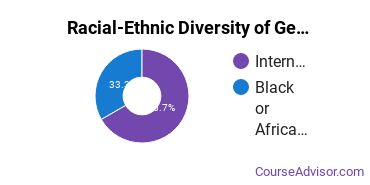General Education at University of Delaware
If you are interested in studying general education, you may want to check out the program at University of Delaware. The following information will help you decide if it is a good fit for you.UD is located in Newark, Delaware and approximately 23,613 students attend the school each year.
Want to know more about the career opportunities in this field? Check out the Careers in General Education section at the bottom of this page.
UD General Education Degrees Available
- Master’s Degree in Education
UD General Education Rankings
There were 7 students who received their doctoral degrees in education. This makes the school the #51 most popular school in the United States for this category of students.
Education Student Demographics at UD
Take a look at the following statistics related to the make-up of the education majors at University of Delaware.
UD General Education Master’s Program

Of the students who received a education master's degree from UD, 57% were white. This is typical for this degree on the natiowide level.
The following table and chart show the race/ethnicity for students who recently graduated from University of Delaware with a master's in education.

| Race/Ethnicity | Number of Students |
|---|---|
| Asian | 0 |
| Black or African American | 2 |
| Hispanic or Latino | 0 |
| White | 4 |
| International Students | 1 |
| Other Races/Ethnicities | 0 |
Concentrations Within General Education
General Education majors may want to concentrate their studies in one of these areas. The table shows all degrees awarded in this field awarded for all degree levels at University of Delaware. A concentration may not be available for your level.
| Concentration | Annual Degrees Awarded |
|---|---|
| General Education | 10 |
Related Majors
- Educational Assessment
- Instructional Media Design
- Other Education
- Teaching English or French
- Special Education
Related Programs
Learn about other programs related to University of Delaware that might interest you.
MEd in Curriculum & Instruction
Enhance your career as a teacher or administrator or prepare to advance to a leadership position within your school with this specialized online MEd from Southern New Hampshire University.
MS in Higher Education Administration
Learn how strategic leadership, data-driven resource management and a culture centered on student success can enhance colleges and universities with this online master's from Southern New Hampshire University.
Careers That Education Grads May Go Into
A degree in education can lead to the following careers. Since job numbers and average salaries can vary by geographic location, we have only included the numbers for DE, the home state for University of Delaware.
| Occupation | Jobs in DE | Average Salary in DE |
|---|---|---|
| Education Professors | 200 | $79,690 |
References
*The racial-ethnic minorities count is calculated by taking the total number of students and subtracting white students, international students, and students whose race/ethnicity was unknown. This number is then divided by the total number of students at the school to obtain the racial-ethnic minorities percentage.
- College Factual
- National Center for Education Statistics
- O*NET Online
- Image Credit: By Ottawa80 at English Wikipedia under License
More about our data sources and methodologies.

